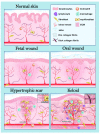Toward understanding scarless skin wound healing and pathological scarring
- PMID: 31231509
- PMCID: PMC6556993
- DOI: 10.12688/f1000research.18293.1
Toward understanding scarless skin wound healing and pathological scarring
Abstract
The efficient healing of skin wounds is crucial for securing the vital barrier function of the skin, but pathological wound healing and scar formation are major medical problems causing both physiological and psychological challenges for patients. A number of tightly coordinated regenerative responses, including haemostasis, the migration of various cell types into the wound, inflammation, angiogenesis, and the formation of the extracellular matrix, are involved in the healing process. In this article, we summarise the central mechanisms and processes in excessive scarring and acute wound healing, which can lead to the formation of keloids or hypertrophic scars, the two types of fibrotic scars caused by burns or other traumas resulting in significant functional or aesthetic disadvantages. In addition, we discuss recent developments related to the functions of activated fibroblasts, the extracellular matrix and mechanical forces in the wound environment as well as the mechanisms of scarless wound healing. Understanding the different mechanisms of wound healing is pivotal for developing new therapies to prevent the fibrotic scarring of large skin wounds.
Keywords: extracellular matrix; fibrosis; hypertrophic scar; keloid; myofibroblast; wound healing.
Conflict of interest statement
No competing interests were disclosed.No competing interests were disclosed.No competing interests were disclosed.
Figures

References
Publication types
MeSH terms
LinkOut - more resources
Full Text Sources

